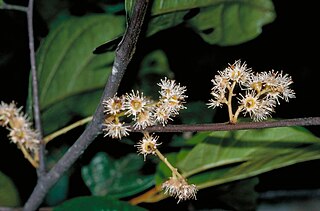
Sterculia quadrifida, also known as the peanut tree, monkey nut or red-fruited kurrajong is a small tree that grows in the rainforests, vine thickets, and gallery forests of New Guinea and northern Australia.

Eupomatia laurina, commonly named bolwarra, native guava or copper laurel, is a species of plant in the primitive flowering-plant family Eupomatiaceae endemic to Australia and New Guinea.

Atalaya is a genus of eighteen species of trees and shrubs of the plant family Sapindaceae. As of 2013 fourteen species grow naturally in Australia and in neighbouring New Guinea only one endemic species is known to science. Three species are known growing naturally in southern Africa, including two species endemic to South Africa and one species in South Africa, Eswatini and Mozambique.

Myristica globosa is a species of plant in the family Myristicaceae. It is found in parts of Melanesia and Australia.

Alpinia caerulea, commonly known as native ginger or Australian ginger, is an understorey perennial herb in the family Zingiberaceae which grows in rainforest, gallery forest and wet sclerophyll forest in eastern Australia.
Beilschmiedia bancroftii is a tree species in the family Lauraceae. It is native to Queensland in Australia. Common names include yellow walnut, yellow nut and canary ash.

Cryptocarya triplinervis is a rainforest tree growing in eastern Australia. Common names include the three veined laurel, three veined cryptocarya and the brown laurel.

Bleasdalea bleasdalei is a species of rainforest tree in the family Proteaceae from Far North Queensland. First described as Grevillea bleasdalei by Ferdinand von Mueller, it was placed in its current genus in 1975.

Clerodendrum floribundum, known as the lolly bush or smooth clerodendrum, is a shrub or tree found in Australia and New Guinea. Its habitat is in or at the margins of coastal rainforests, up to 300 metres above sea level. In Western Australia it grows in drier areas, such as rocky sites, gorges, cliffs, floodplains and creek beds.

Ganophyllum falcatum, commonly known as the scaly ash, is an evergreen rainforest tree. It grows up to 32 metres high and has rough, flaky bark. The species was described by German-Dutch botanist Carl Ludwig Blume in 1851 based on plant material collected from the coast of New Guinea.It is native to Africa, the Andaman Islands, Asia, Malesia and northern Australia. The ovoid fruits are consumed by fruit pigeons and cassowaries.

Carnarvonia araliifolia, commonly known as the red oak, red silky oak, Caledonian oak or elephant's foot, is the sole species in the genus Carnarvonia, a member of the Proteaceae family. It is endemic to the rainforests of northeastern Queensland, Australia.

Nothorites is a monotypic genus in the macadamia family Proteaceae. The sole species, Nothorites megacarpus, is endemic to the wet tropics rain forests of northeastern Queensland, Australia.

Terminalia microcarpa is a tree species in the family Combretaceae. It occurs throughout the Philippines, in parts of Malaysia and Indonesia, Papua New Guinea, possibly the Bismarck Archipelago, and northern Australia. It is cultivated on a small scale in the Philippines, where the edible sweet and tart plum-like fruits are eaten as is or are traditionally made into jams, jellies, and wines.

Helicia nortoniana, also known as Norton's silky oak, is a species of tree in the family Proteaceae growing to about 20 m (66 ft) tall. It is endemic to the rainforests of the Wet Tropics region of Queensland, Australia, and occurs at altitudes from sea level to about 1,000 m (3,300 ft).

Prunus turneriana is a species of plant in the rose, apple and peach family Rosaceae, native to New Guinea and Australia. Its common names include almondbark, wild almond, and joonda. The name almondbark refers to the almond-like odour emitted when the bark is cut. A late successional rainforest tree, it reaches 30 m (98 ft). The fruit is eaten by cassowaries, fruit pigeons, Herbert River ringtail possums and musky rat-kangaroos.

Atractocarpus hirtus, commonly known as the hairy gardenia or native loquat, is a plant in the coffee family Rubiaceae, a large family of some 6,500 species with a cosmopolitan distribution. This species is endemic to northeastern Queensland, Australia.

Syzygium branderhorstii, commonly known as the Lockerbie satinash, is a small tree in the family Myrtaceae found in New Guinea, the Bismarck Archipelago, Solomon Islands, Santa Cruz Islands, and northern Queensland, Australia. It is cauliflorous, producing large inflorescences from the trunk. The fruits are eaten by brush turkeys.

Amomum queenslandicum, commonly known as Cape York ginger, is a plant in the ginger family Zingiberaceae found in New Guinea and a small part of Cape York Peninsula, Queensland, Australia.

Beilschmiedia tooram, commonly known as coach walnut, brown walnut or Tooram's walnut, is a tree in the family Lauraceae found only in the Wet Tropics bioregion of Queensland, Australia. It was first described by Frederick Manson Bailey as Endiandra tooram in 1901, and transferred to the genus Beilschmiedia in an extensive review of Australian Lauraceae by Bernard Hyland in 1989.

Ophiorrhiza australiana, commonly known as australian snakeroot, is a rainforest shrub in the coffee family Rubiaceae found only in the Wet Tropics bioregion of Queensland, Australia. It was first described in 1867 by the English botanist George Bentham.




















